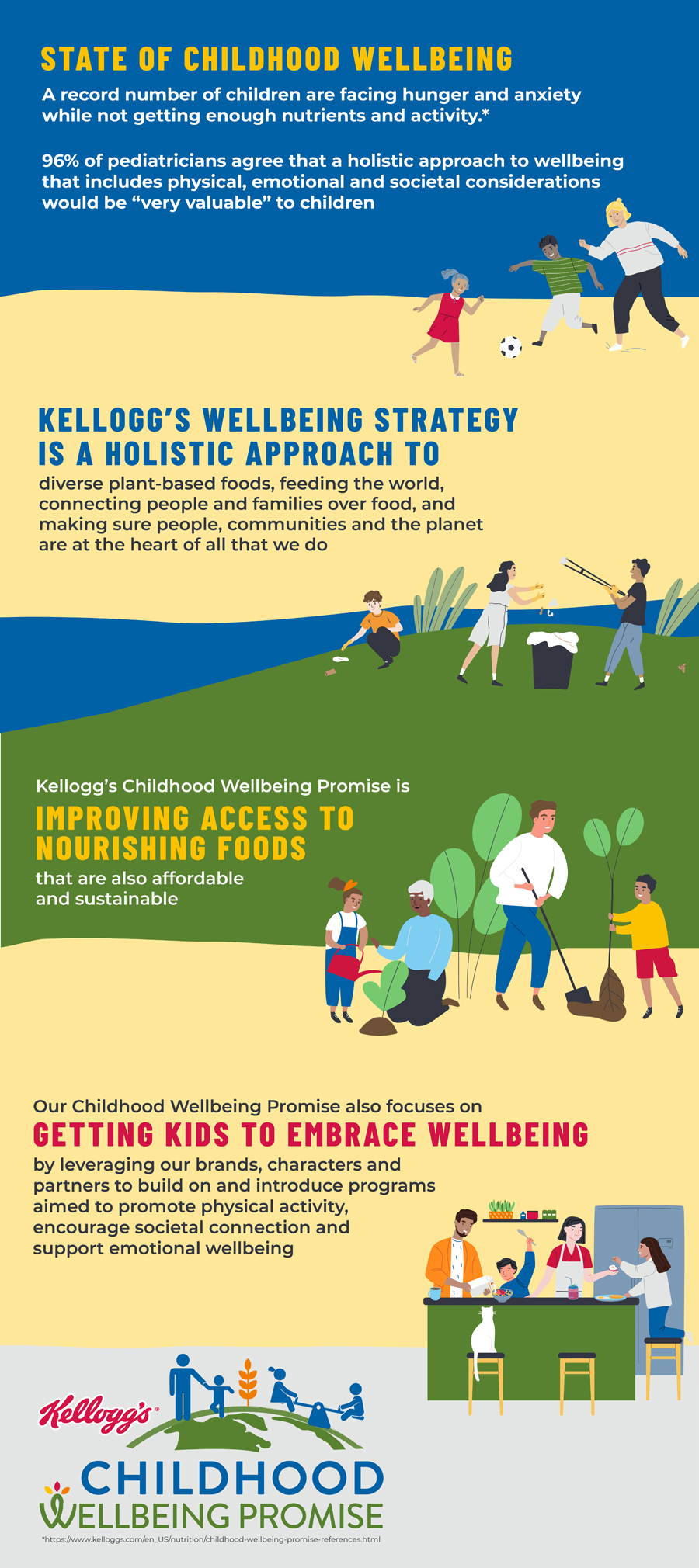
- About Us
- Wellbeing
- Hunger
- Sustainability
- ED&I
- People
- Reporting
Childhood Wellbeing Promise
Delivering on our promise to support children’s wellbeing
Childhood obesity is one of the great public health challenges of our time. In the U.S., 9 in 10 children fail to achieve the Institute of Medicine’s recommendation for fiber intake, and their consumption of fruits, vegetables and whole grains is well below recommendations. Additionally, more young people are experiencing anxiety and stress, and most children are not engaging in enough physical activity, all while obesity rates continue to rise. We believe a more holistic approach to children’s health and wellbeing focused on eating patterns, physical activity, social connectivity, education and reading, and improving food security may result in better outcomes.
Building on this knowledge, we developed the Kellogg Childhood Wellbeing Promise in 2020 to positively affect all aspects of wellbeing as referenced above, of children and families. The Promise was developed in consultation with external key nutrition, health and wellbeing influencers, and we continue to collaborate with partners and other stakeholders. In addition, we have engaged an independent, third-party firm to provide an annual audit of the Promise against several key measures.
Rolling out first in the U.S. in 2021, the global Promise focuses on two key pillars: 1) helping to improve access to nourishing, affordable, sustainable foods and 2) motivating kids to embrace wellbeing including emotional aspects, such as societal connection, education and reading, and physical activity.
- In the U.S., some of the ways we are improving access to food include strengthening our internal standards for foods marketed to children under 12 – the Kellogg Worldwide Marketing and Communication Guidelines (KWWMCG) – and evolving our portfolio of foods most visible to kids to enable positive eating habits, delivering shortfall nutrients like fiber and vitamin D and driving whole grain, fruit and vegetable intake. We are focused on increasing access to these foods through WIC and schools. And through the Promise, focusing on increasing portion-controlled servings and messaging, as we understand that a balanced approach to wellbeing starts with balanced consumption.
- To help motivate kids to embrace wellbeing in the U.S., we will intentionally bring wellbeing messaging to life by leveraging our brands, characters and partners to build on and introduce programs aimed to promote physical activity, encourage societal connection and support emotional wellbeing, including reading. This includes building on programs like Mission Tiger, Feeding Reading and creating educational tools for schools and youth organizers.
Progress since 2020:
- 2.6 million kids reached through Mission Tiger middle school sports donations and Feeding Reading book donations
- 9,000 school educators and youth organizers reached with tools to enable Wellbeing education, such as recipes meeting nutrition standards and global flavor trends
- Launched four additional WIC eligible cereals, including the first organic WIC eligible cereal

References
Atlas of Childhood Obesity; October 2019. http://s3-eu-west-1.amazonaws.com/wof-files/WOF_Childhood_Obesity_Atlas_Report_Oct19_V2.pdf
Youth Risk Behavior Surveillance System updated report on the prevalence of physical activity in youth (grades 9 – 12) and the National Physical Activity Plan Alliance (part of DHHS) issues a Report Card on Physical Activity in Children and Youth. https://www.cdc.gov/healthyyouth/data/yrbs/index.htm
Dietary Guidelines for American’s 2015-2020. U.S. Department of Agriculture. https://health.gov/dietaryguidelines/2015/guidelines/chapter-2/a-closer-look-at-current-intakes-and-recommended-shifts/
Journal of Developmental and Behavioral Pediatrics. Based on data collected from the National Survey of Children’s Health
2020 PULSE survey of 2500 pediatric professionals. Q1 – How valuable do you feel a more holistic approach to childhood wellbeing would be – that includes emotional, physical (including nutrition) and societal wellbeing – compared to focusing on nutrition alone?

